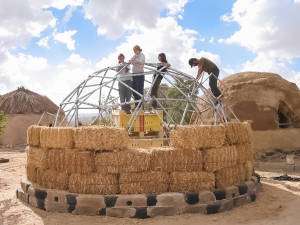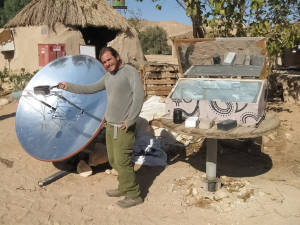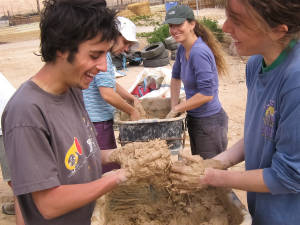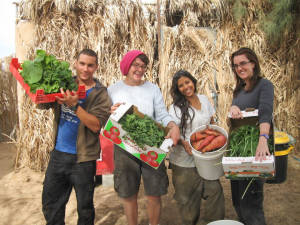
Israel’s Kibbutz Lotan: Going Back in Time in Order to Find The Future
“In order to think out of a box, you can’t live in a box. Something about living in a round place makes us think differently.” Alex Cicelsky, a program director at Kibbutz Lotan, is talking about the 10 geodesic domes on the kibbutz. These domes are arranged side-by-side and are part of Lotan’s Eco-Campus, a representation and embodiment of the values of Israel’s Kibbutz Lotan as a whole: community, creativity, sustainability, innovation, and fun.
Kibbutz Lotan is a sustainable living community in the heart of the Arava Valley in the south of Israel. Removed from pollution, cars, and city noise, it’s a thriving center for ecological innovation and sustainability. Kibbutz Lotan was founded in 1983 and currently has 160 residents, along with a range of students and visitors depending on the season. It is the youngest Kibbutz in Israel and has been listed one of “the top three places to visit” by Lonely Planet Israel. Visitors will find Kibbutz Lotan in the low point of the valley, with a unique climate condition that is mainly desert.
Mark Naveh is the program director at Kibbutz Lotan, who I encountered on a recent visit to the community. Naveh teaches courses and leads different groups who come visit, from university students to academics and travelers wanting to learn more about sustainable living. During my visit I had the chance to speak with him and learn about the philosophy and values behind this innovative community: “The original idea was to create an all-encompassing community which would take the ideas of reform Judaism and place it in the context of an agricultural cooperative kibbutz,” he told me. Over the years the kibbutz changed its economic model, but the main ethics of the community, and its strive for ecological consciousness, have remained at its core.
There are so many initiatives and projects going on simultaneously at Lotan that it’s almost difficult to keep up. From the bird reserve to the “electricity free” microwave, the organic garden, composting, and architectural domes, it’s possible to find an innovative project at the turn of every corner. All of these projects are created and sustained by the community of families who live on the kibbutz, or by students who go there to learn.
One of my favorite parts of Lotan was the geodesic domes, aka the igloo homes…They are made from a skeleton of steel metal poles, and straw bales that are then covered with mud on the inside and outside. Apart from the fact that they are cozy places to live, they also preserve an incredible amount of energy, in addition to being fire proof and constructed to survive earthquakes. “We found that they save up to 70% of energy from the buildings made out of concrete,” Naveh said. “These structures don’t need any heating in the winter, and they minimize the need for electricity in the summer.”
The idea is that these buildings can serve as a prototype for this area and other desert regions in the world– where water is often at a premium. (If you’re curious, you can watch this youtube series produced by the Kibbutz for a step-by-step tutorial on how to build one yourself).
The domes at Kibbutz Lotan are also beautiful structures, each one of them displaying the builder’s unique aesthetic eye. One dome has two hands wrapping around the entrance, enveloping the visitor. Throughout the community there are elements of fun and playfulness built into each structures’ design and functioning as a reminder that everything here has been conceived and created by the community that lives in the Kibbutz.
Standing in one of these domes made me reconsider what constitutes a building and how I’ve been taught they must be made (e.g. four walls, concrete). Can building a home actually be much more simple? And if so, what else is possible?
For people who want to dive deeper into ecological living, Lotan offers The Green Apprenticeship program, a four-week course for practical and sustainable development and permaculture design. (It’s one of the main course offerings.) Students of the program live in and maintain the geodesic domes, which have been built by former students themselves. “They are really living what they are learning in the course, because they take part in the research and development, they take part in maintaining the neighborhood, and they create community within the campus,” Naveh tells me, beaming.
Lotan’s vision is to send people out into the world as agents of change. The feedback they get from past students as they get involved in different projects internationally– pursuing careers in fields like architecture, entrepreneurship, social activism, and environmental education– is inspiring to say the least. “We’re creating– slowly and quietly– a grassroots revolution which will hopefully bring a very positive message into the world,” Naveh says.
Apart from the apprenticeship program, the kibbutz also hosts a variety of other hands-on courses for visitors and tourists, including workshops on local food production, “green” building, and sustainable community.
Visitors come to Kibbutz Lotan from far and wide, many of them having heard about it through word-of-mouth. Most of the students from the Green Apprenticeship program are international. Kibbutz Lotan is also a part of the Global Ecovillage Network, an international network “connecting communities for a sustainable world”.
Recently, Lotan has also established an Israeli network of ecological villages and communities as a way to start a similar network in their home country. (So far they’ve had two annual conferences.) This development, which was initialized by the community, is exciting because it shows that more people are becoming aware– and more importantly, open— to the idea that communities can and should create living places that are good for the community and the planet.
Lotan is a model community for others to take and adapt to the places they are living. Always growing and evolving as they learn more and experiment, one of the core questions Lotan seeks to answer is how to create a suitable community. “That’s really the challenge we are trying to answer,” Naveh emphasizes as we chat. “With sustainable communities we can deal with all the problems we are facing, whether it’s climate change, social issues, or economic issues”.
Everything about Kibbutz Lotan pulses with creativity, from the energy of the residents to the students to the actual buildings themselves. If this type of innovation can happen in the harsh conditions of Israel’s Arava Valley, it’s indeed possible that with a little ingenuity and planning, it could happen anywhere.






































